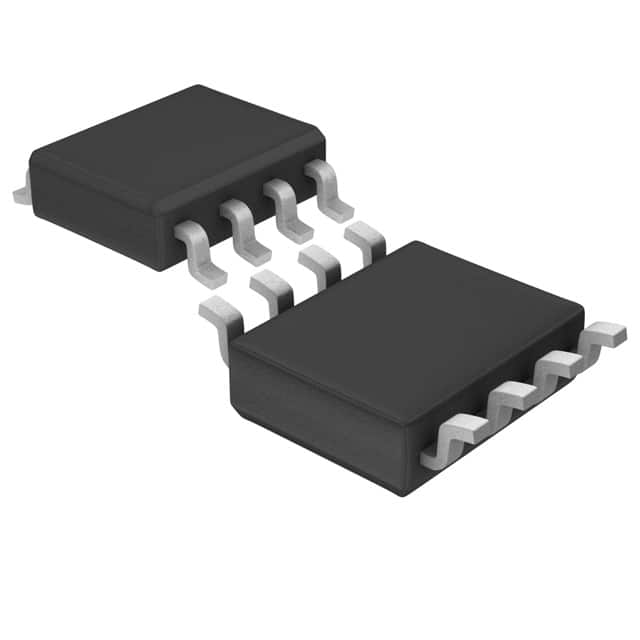LT1004CS8-2.5#TRPBF
Basic Information Overview
Category: Integrated Circuit (IC)
Use: Voltage Reference
Characteristics: - Precision voltage reference - Low dropout voltage - High accuracy and stability - Wide operating temperature range - Low quiescent current
Package: SOIC-8
Essence: The LT1004CS8-2.5#TRPBF is a precision voltage reference IC that provides a stable and accurate output voltage of 2.5V.
Packaging/Quantity: The LT1004CS8-2.5#TRPBF is available in tape and reel packaging, with 2500 units per reel.
Specifications
- Output Voltage: 2.5V ± 0.4%
- Dropout Voltage: 300mV (typical)
- Quiescent Current: 60µA (typical)
- Temperature Coefficient: 10ppm/°C (maximum)
- Operating Temperature Range: -40°C to 125°C
Detailed Pin Configuration
The LT1004CS8-2.5#TRPBF has the following pin configuration:
```
| | --| VOUT | --| GND | --| NC | --| NC | --| NC | --| NC | --| VIN | |___________| ```
Functional Features
- High accuracy: The LT1004CS8-2.5#TRPBF provides a precise and stable output voltage of 2.5V, ensuring reliable performance in various applications.
- Low dropout voltage: With a low dropout voltage of 300mV, this voltage reference can operate efficiently even when the input voltage is close to the desired output voltage.
- Low quiescent current: The IC has a low quiescent current of 60µA, making it suitable for battery-powered applications.
- Wide operating temperature range: The LT1004CS8-2.5#TRPBF can operate in a wide temperature range from -40°C to 125°C, making it suitable for harsh environments.
Advantages and Disadvantages
Advantages: - High accuracy and stability - Low dropout voltage - Low quiescent current - Wide operating temperature range
Disadvantages: - Limited output voltage options (only 2.5V)
Working Principles
The LT1004CS8-2.5#TRPBF is based on bandgap reference technology. It utilizes the temperature-dependent voltage across a forward-biased base-emitter junction of a bipolar transistor to generate a stable reference voltage. This voltage is then amplified and regulated to provide a precise output voltage of 2.5V.
Detailed Application Field Plans
The LT1004CS8-2.5#TRPBF is commonly used in various applications that require a stable and accurate voltage reference. Some of its application fields include:
- Precision analog circuits
- Data acquisition systems
- Industrial control systems
- Portable electronic devices
- Battery management systems
Detailed and Complete Alternative Models
Some alternative models that can be considered as alternatives to the LT1004CS8-2.5#TRPBF are:
- LM4040CIZ-2.5/NOPB
- REF102CU
- MAX6126AASA25
These models offer similar characteristics and performance, providing alternative options for voltage reference applications.
In conclusion, the LT1004CS8-2.5#TRPBF is a precision voltage reference IC with high accuracy, stability, and a low dropout voltage. It is widely used in various applications that require a stable and accurate reference voltage. Alternative models such as LM4040CIZ-2.5/NOPB, REF102CU, and MAX6126AASA25 can also be considered for similar applications.
قم بإدراج 10 أسئلة وإجابات شائعة تتعلق بتطبيق LT1004CS8-2.5#TRPBF في الحلول التقنية
Sure! Here are 10 common questions and answers related to the application of LT1004CS8-2.5#TRPBF:
Q: What is the LT1004CS8-2.5#TRPBF? A: The LT1004CS8-2.5#TRPBF is a precision voltage reference IC manufactured by Linear Technology (now part of Analog Devices). It provides a stable and accurate 2.5V output voltage.
Q: What is the typical application of LT1004CS8-2.5#TRPBF? A: The LT1004CS8-2.5#TRPBF is commonly used as a reference voltage source in various electronic circuits, such as analog-to-digital converters (ADCs), digital-to-analog converters (DACs), voltage regulators, and other precision measurement systems.
Q: What is the voltage accuracy of LT1004CS8-2.5#TRPBF? A: The LT1004CS8-2.5#TRPBF has a typical voltage accuracy of ±0.8% at room temperature. However, it can be trimmed for even higher accuracy if required.
Q: What is the temperature coefficient of LT1004CS8-2.5#TRPBF? A: The temperature coefficient of the LT1004CS8-2.5#TRPBF is typically 20ppm/°C, meaning that the output voltage changes by 20 parts per million for every degree Celsius change in temperature.
Q: What is the maximum operating current of LT1004CS8-2.5#TRPBF? A: The LT1004CS8-2.5#TRPBF can operate with a maximum current of 10mA. It is important to ensure that the load current does not exceed this limit.
Q: Can LT1004CS8-2.5#TRPBF be used in battery-powered applications? A: Yes, the LT1004CS8-2.5#TRPBF can be used in battery-powered applications as it has a low quiescent current of typically 60µA, making it suitable for power-constrained designs.
Q: Does LT1004CS8-2.5#TRPBF require an external voltage regulator? A: No, the LT1004CS8-2.5#TRPBF does not require an external voltage regulator. It is a self-contained voltage reference IC that provides a stable output voltage without the need for additional components.
Q: What is the package type of LT1004CS8-2.5#TRPBF? A: The LT1004CS8-2.5#TRPBF is available in an 8-pin SOIC (Small Outline Integrated Circuit) package, which is commonly used in surface-mount applications.
Q: Can LT1004CS8-2.5#TRPBF operate over a wide temperature range? A: Yes, the LT1004CS8-2.5#TRPBF is designed to operate over a wide temperature range, typically from -40°C to +85°C, making it suitable for various environmental conditions.
Q: Are there any application notes or reference designs available for LT1004CS8-2.5#TRPBF? A: Yes, Analog Devices provides application notes and reference designs on their website that offer guidance on using the LT1004CS8-2.5#TRPBF in different circuit configurations and applications. These resources can be helpful in designing with this voltage reference IC.
Please note that the answers provided here are general and may vary depending on specific datasheet specifications and application requirements. It is always recommended to refer to the official datasheet and consult with technical experts for accurate information and guidance.


